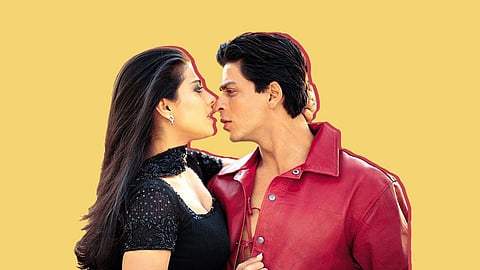
- Reviews
- Power List 2024
- Cannes 2024
- In-Depth Stories
- Web Stories
- News
- FC Lists
- Interviews
- Features
- FC SpecialsFC Specials

Dreamy sequences have been a significant part of Indian cinema for decades. These sequences often provide a glimpse into a character's inner world, giving the audience a chance to understand their psyche and desires. They also serve as a form of escapism for the audience, transporting them to stunning locations that sometimes fit within the film's narrative. These sequences that are usually picturized on songs have often been blamed for interrupting the flow of the story. Lalitha Gopalan, a film theorist, believes that this makes for a "cinema of interruption." I disagree with this notion as I think these sequences provide a space to dream.
One of the most iconic dream sequences in Bollywood is the song "Suraj Hua Maddham" from the film Kabhi Khushi Kabhie Gham (2001). The sequence shows Anjali (Kajol) dreaming of Rahul (Shah Rukh Khan), expressing her desire for him. The sequence is shot in a breathtaking location, adding to the overall appeal of the song. What also makes this song noteworthy is that it allows the character to transcend into a world that is prohibited to her.
Another example of a dream sequence is the song "Tere Bina" from the film Guru (2007). The sequence shows Sujata (Aishwarya Rai Bachchan) longing for her husband (Abhishek Bachchan) after they separate owing to a fight. The sequence is shot in dramatic locations, giving the audience respite from the monotonous narrative of the film. In my opinion, "Yeh Kahan Aa Gaye Hum" from Silsila (1981) serves the same purpose.
One of the most intriguing cases of wistful sequences is Kabhi Alvida Naa Kehna's “Tumhi Dekho Naa". What makes it different from other song sequences is that the couple, played by Rani Mukherjee and Shah Rukh Khan, do not envision themselves against exotic backdrops. Instead, they see themselves in the crowds of New York, where they live. The sequence lets them colour the city with their illicit love affair, but in reality, they are a part of a restrictive society, and try as they might, they cannot ignore that.
A song sequence that has been widely written about is “Satrangi Re” from Dil Se (1998). What stands out about it is that Amar (Shah Rukh Khan) doesn’t imagine his love interest reciprocating his feelings but instead, treating him coldly. He thinks of fire, mesh and ruins, heightening the morbidity of the climax. There is a sense of destructiveness in their love. Amar doesn’t hope for a content, favourable future with Meghna (Manisha Koirala). With his masochistic traits, he is keen to be destroyed by his lover. He doesn’t yearn to spend his life with Meghna blissfully. Instead, he prophesies his death with her. The film has three major song sequences and all of them depict the characters' desires that cannot be displayed otherwise, owing to their dark themes.
In conclusion, dream sequences in Hindi films provide filmmakers the unique opportunity to present their characters' inner worlds. The characters have the privilege to communicate without putting themselves out there, a liberty we can only yearn for.